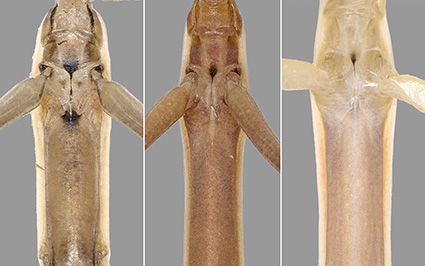Abstract
To date, no accurate identification method has been established for distinguishing mantis species of the genus Tenodera at all instar nymphal stages. In this paper, all instar nymphal stages of Tenodera fasciata (Olivier, 1792) are described in detail. This is the first step toward establishing an identification method for distinguishing the species from other members of the genus, particularly, T. angustipennis Saussure, 1869, which is sympatric with T. fasciata in Japan. Morphological differences between instars in nymphal stages, and between male and female in nymphal stages, were found. However, there was no difference between male and female 1st instars. Sex in nymphal stages are identified by the presence or absence of a crack at the posterior margin of the abdominal sternite IX between immature gonoplacs, the shape of the posterior margin of the sternites VII and IX, the occurrence of gonapophyses on the sternite VIII, and so on. Instars in nymphal stages are identified by body length, the length of discoidal spines of the profemur, the shape and size of the wing pads, the shape of abdominal sternite VII to IX, and so on.
References
Brannoch, S.K., Wieland, F., Rivera, J., Klass, K.-D., Béthoux, O. & Svenson, G.J. (2017) Manual of praying mantis morphology, nomenclature, and practices (Insecta, Mantodea). Zookeys, 696, 1–100. https://doi.org/10.3897/zookeys.696.12542
Ehrmann, R. (2002) MANTODEA Gottesanbeterinnen der Welt. Natur und Tier, Münster, 519 pp. [in German]
Ehrmann, R. & Borer, M. (2015) Mantodea (Insecta) of Nepal: an annotated checklist. In: Hartmann, M. & & Weipert, J. (Eds.), Biodiversität und Naturausstattung im Himalaya. Band V. Naturkundemuseum, Erfurt, pp. 227–274.
Iwasaki, T. (1992) Stage duration, size and coloration of two praying mantises, Tenodera aridifolia (Stoll) and Tenodera angustipennis Saussure (Mantodea: Mantidae). Japanese Journal of Entomology, 60, 551–557.
Jensen, D., Svenson, G.J., Song, H. & Whiting, M.F. (2009) Phylogeny and evolution of male genitalia within the praying mantis genus Tenodera (Mantodea: Mantidae). Invertebrate Systematics, 23, 409–421. https://doi.org/10.1071/IS09004
Matsuda, R. (1976) Morphology and evolution of the insect abdomen. Pergamon Press, Oxford, 534 pp.
Mukherjee, T.K., Hazra, A.K. & Ghosh, A.K. (1995) The mantid fauna of India (Insecta: Mantodea). Oriental Insects, 29, 185–358. https://doi.org/10.1080/00305316.1995.10433744
Nakamine, H. (2016) Mantodea. In: Orthopterological Society of Japan (Ed.), The Standard of Polyneoptera in Japan. Gakken Plus, Tokyo, pp. 198–205. [in Japanese with English title]
Nickle, D.A. (1987) Order Mantodea. In: Stehr, F.W. (Ed.), Immature Insects. Kendall/Hunt, Dubuque, Iowa, pp. 140–142.
Okada, M. (2001) Kontyû-hantâ Kamakiri no subete [All of mantis insect hunters]. Tonbo-shuppan, Osaka, 63 pp. [in Japanese]
Okada, M. (2004) Ô-kamakiri-rui 3shu no ukagara deno shikibetsuten [Discrimination of three species of Tenodera in the exuvia]. Gekkan-Mushi, monthly Journal of Entomology, 406, 28. [in Japanese]
Oshima, K. (2018) New records of six species of Mantodea from some islands adjacent to Okinawa-jima Island, the Ryukyus, Japan. Japanese Journal of Entomology, New Series, 2, 151–160.
Patel, S. & Singh, R. (2016) Updated checklist and distribution of Mantidae (Mantodea: Insecta) of the world. International Journal of Research Studies in Zoology, 2 (4), 17–54. https://doi.org/10.20431/2454-941X.0204003
Roberto, B., Luca, P., Paolo, F. & Judith, M. (2010) Mantids of the Euro-Mediterranean Area. World Biodiversity Association onlus, Verona, 232 pp.
Schwarz, C.J. & Konopik, O. (2014) An annotated checklist of the praying mantises (Mantodea) of Borneo, including the results of the 2008 scientific expedition to Lanjak Entimau Wildlife Sanctuary, Sarawak. Zootaxa, 3797 (1), 130–168. https://doi.org/10.11646/zootaxa.3797.1.12
Steinmann, H. & Zombori, L. (1984) A morphological atlas of insect larvae. Akadémiai Kiadó, Budapest, 403 pp.
Thịnh, T.H. (2010) Dana Muc Loai Bo Ngua (Mantodea, Insecta) o Viet Nam [A list of praying mantids (Mantodea, Insecta) of Vietnam]. Tạp chí Sinh Hoc, 32, 17–25. [in Vietnamese] https://doi.org/10.15625/0866-7160/v32n1.647


